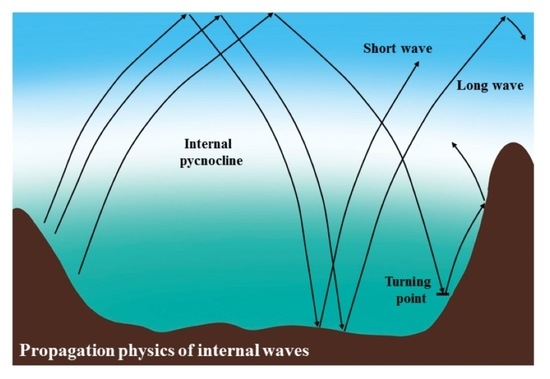A Characteristics Set Computation Model for Internal Wavenumber Spectra and Its Validation with MODIS Retrieved Parameters in the Sulu Sea and Celebes Sea
Abstract
:1. Introduction
2. Materials and Methods
2.1. Model Derivation and Set-Up
2.1.1. Derivation of Internal Wave Energy Spectrum Balance Equation
2.1.2. 3-Dimensional Complicated Characteristics Set Equations
2.1.3. Reflection at the Surface and Bottom
2.1.4. Grid Distribution and Complicated Characteristics Inlaid Scheme in Physical and Phase Spaces
2.2. Ocean Data
2.2.1. MODIS Data
2.2.2. Modeled Data
3. Results
3.1. Validation
3.1.1. Simplified Wave Frequency Dispersion Relations
3.1.2. MODIS Retrieved Parameters and Comparison with Modeled Results
3.2. Analysis of Spectral Propagation
4. Discussion
5. Conclusions
Author Contributions
Funding
Data Availability Statement
Acknowledgments
Conflicts of Interest
References
- Liu, A.K.; Holbrook, J.R.; Apel, J.R. Nonlinear internal wave evolution in the Sulu Sea. J. Phys. Oceanogr. 1985, 15, 1613–1624. [Google Scholar] [CrossRef] [Green Version]
- Yuan, Y.L.; Han, L.; Qiao, F.L.; Yang, Y.Z.; Lu, M. A unified linear theory of wavelike perturbations under general ocean conditions. Dyn. Atmos. Oceans 2011, 51, 55–74. [Google Scholar] [CrossRef]
- Yuan, Y.L.; Qiao, F.L.; Yin, X.Q.; Han, L. Establishment of the ocean dynamic system with four sub-systems and the derivation of their governing equation sets. J. Hydrodyn. 2012, 24, 153–168. [Google Scholar] [CrossRef]
- Whitham, G.R. Linear and Nonlinear Waves; John wiley and Sons Inc.: London, UK, 1974. [Google Scholar]
- Phillips, O.M. Dynamics of the Upper Ocean; Cambridge University Press: Cambridge, UK, 1977. [Google Scholar]
- Yuan, Y.L.; Hua, F.; Pan, Z.D.; Sun, L.T. LAGFD-WAM numerical wave model—I. Basic physical model. Acta Oceanol. Sin. 1991, 10, 483–488. [Google Scholar]
- Yang, Y.Z.; Qiao, F.L.; Zhao, W.; Teng, Y.; Yuan, Y.L. MASNUM ocean wave model in spherical coordinate and its application. Acta Oceanol. Sin. 2005, 27, 1–7. [Google Scholar]
- Jackson, C. Internal wave detection using the Moderate Resolution Imaging Spectroradiometer (MODIS). J. Geophys. Res. 2007, 112, C11012. [Google Scholar] [CrossRef] [Green Version]
- Alpers, W. Theory of radar imaging of internal waves. Nature 1985, 314, 245–247. [Google Scholar] [CrossRef]
- Munk, W.; Armi, L.; Fischer, K.; Zachariasen, F. Spirals on the Sea. Proc. R. Soc. 2000, 456, 1217–1280. [Google Scholar] [CrossRef]
- Sun, L.N.; Zhang, J.; Meng, J.M. Study on the propagation velocity of internal solitary waves in the Andaman Sea using Terra/Aqua-MODIS remote sensing images. J. Ocean. Limnol. 2021, 39, 2195–2208. [Google Scholar] [CrossRef]
- Yang, Y.Z.; Shi, Y.F.; Yu, C.C.; Teng, Y.; Sun, M. Study on surface wave-induced mixing of transport flux residue under typhoon conditions. J. Oceanol. Limnol. 2019, 37, 1837–1845. [Google Scholar] [CrossRef]
- Babanin, A.V. On a wave induced turbulence and a wave-mixed upper ocean layer. Geophys. Res. Lett. 2006, 33, L20605. [Google Scholar] [CrossRef]
- Dai, D.J.; Qiao, F.L.; Sulisz, W.; Han, L. An experiment on the non-breaking surface-wave-induced vertical mixing. J. Phys. Oceanogr. 2010, 40, 2180–2188. [Google Scholar] [CrossRef]
- Yuan, Y.L.; Qiao, F.L.; Yin, X.Q.; Han, L. Analytical estimation of mixing coefficient induced by surface wave-generated turbulence based on the equilibrium solution of the second-order turbulence closure model. Sci. China Earth Sci. 2013, 56, 71–80. [Google Scholar] [CrossRef]
- Sutherland, B.R. Internal Gravity Waves; Cambridge University Press: Cambridge, UK, 2010; 377p. [Google Scholar]
- Miropol’sky, Y.Z. Dynamics of Internal Gravity Waves in the Ocean; Kluwer Academic Publishers: Dordrecht, The Netherlands, 2001; 406p. [Google Scholar]
- Xu, Z. Dynamics of Ocean Internal Waves; Science Press: Bejing, China, 1999; 336p. [Google Scholar]
- Salomonson, V.V.; Barnes, W.L.; Maymon, P.W.; Montgomery, H.E.; Ostrow, H. MODIS: Advanced facility instrument for studies of the Earth as a system. IEEE Trans. Geosci. Remote Sens. 1989, 27, 145–153. [Google Scholar] [CrossRef]
- Wolfe, R.E. MODIS geolocation. In Earth Science Satellite Remote Sensing; Science and Instruments; Qu, J.J., Gao, W., Kafatos, M., Murphy, R.E., Salomonson, V.V., Eds.; Springer: Berlin/Heidelberg, Germany, 2006; Volume 1, pp. 50–73. [Google Scholar]
- Apel, J.R.; Byrne, H.M.; Proni, J.R.; Charnell, R.L. Observations of oceanic internal and surface waves from the Earth Resources Technology Satellite. J. Geophys. Res. 1975, 80, 865–881. [Google Scholar] [CrossRef]
- Zeng, K.; Alpers, W. Generation of internal solitary waves in the Sulu Sea and their refraction by bottom topography studied by ERS SAR imagery and a numerical model. Int. J. Remote Sens. 2004, 25, 1277–1281. [Google Scholar] [CrossRef]
- Liu, B. Investigate the effect of tides on the internal wave mophorlogy and generation sites in the Sulu Sea using satellite images. In Proceedings of the 2016 IEEE International Geoscience and Remote Sensing Symposium (IGARSS), Beijing, China, 10–15 July 2016; pp. 3986–3988. [Google Scholar] [CrossRef]
- Xia, C.S.; Jung, K.T.; Wang, G.S.; Yin, X.Q.; Guo, J.S. Case study on the three-dimensional structure of meso-scale eddy in the South China Sea based on a high-resolution mode1. Acta Oceanol. Sin. 2016, 35, 29–38. [Google Scholar] [CrossRef]
- Mellor, G.L.; Yamada, T. Development of a turbulence closure model for geophysical fluid problems. Rev. Geophys. 1982, 20, 851–875. [Google Scholar] [CrossRef] [Green Version]
- Yuan, Y.L.; Qiao, F.L.; Hua, F.; Wang, Z. The development of a coastal circulation numerical model: 1. Wave-induced mixing and wave-current interaction. J. Hydrodyn. Ser. A 1999, 14, 1–8. [Google Scholar]
- Qiao, F.L.; Yuan, Y.L.; Yang, Y.Z.; Zheng, Q.A.; Xia, C.S.; Ma, J. Wave-induced mixing in the upper ocean: Distribution and application to a global ocean circulation model. Geophys. Res. Lett. 2004, 31, L11303. [Google Scholar] [CrossRef]
- Babanin, A.V.; Haus, B.K. On the existence of water turbulence induced by non-breaking surface waves. J. Phys. Oceanogr. 2009, 39, 2675–2679. [Google Scholar] [CrossRef]
- Garrett, C.J.R.; Munk, W.H. Space-time scales of internal waves: A progress report. J. Geophys. Res. 1975, 80, 291–297. [Google Scholar] [CrossRef]
- Hsu, M.K.; Liu, A.K.; Lee, C.H. Using SAR images to study internal waves in the Sulu Sea. J. Photogramm. Remote Sens. 2003, 8, 1–14. [Google Scholar]
- Sun, L.N.; Zhang, J.; Meng, J.M. Analysis of spatio-temporal distribution of internal solitary waves in the South China Sea and Sulu Sea (2010–2015). Adv. Mar. Sci 2019, 37, 398–408. [Google Scholar]
- Desaubies, Y.J.F. Internal waves near the turning point. Geophys. Fluid Dyn. 1973, 5, 143–154. [Google Scholar] [CrossRef]
- Desaubies, Y.J.F. A linear theory of internal wave spectra and coherences near the Väisälä frenquency. J. Geophys. Res. 1975, 80, 895–899. [Google Scholar] [CrossRef]
- Munk, W.H. Internal wave spectra at the buoyant and inertial frequencies. J. Phys. Oceanogr. 1980, 10, 1718–1728. [Google Scholar] [CrossRef] [Green Version]
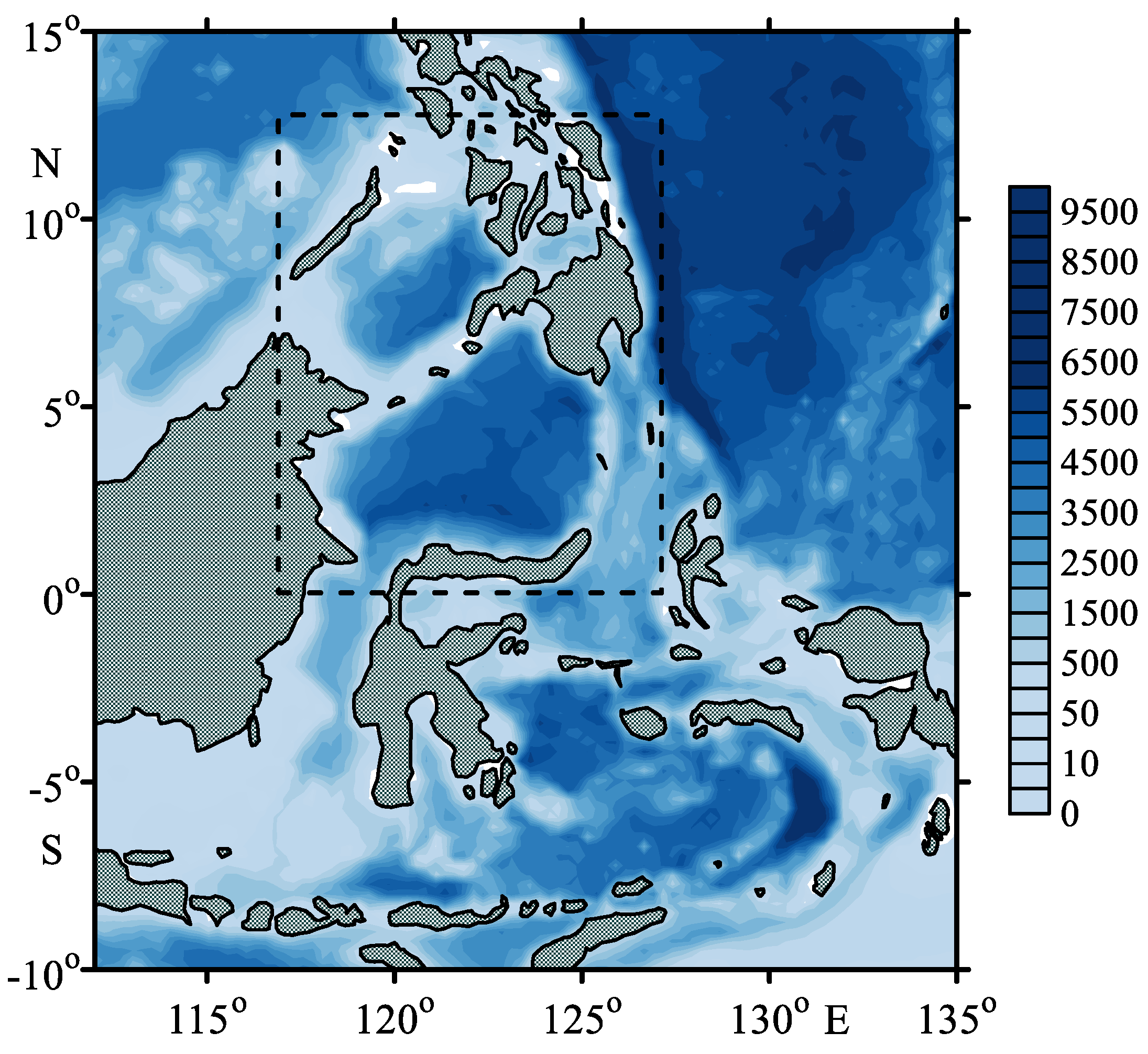
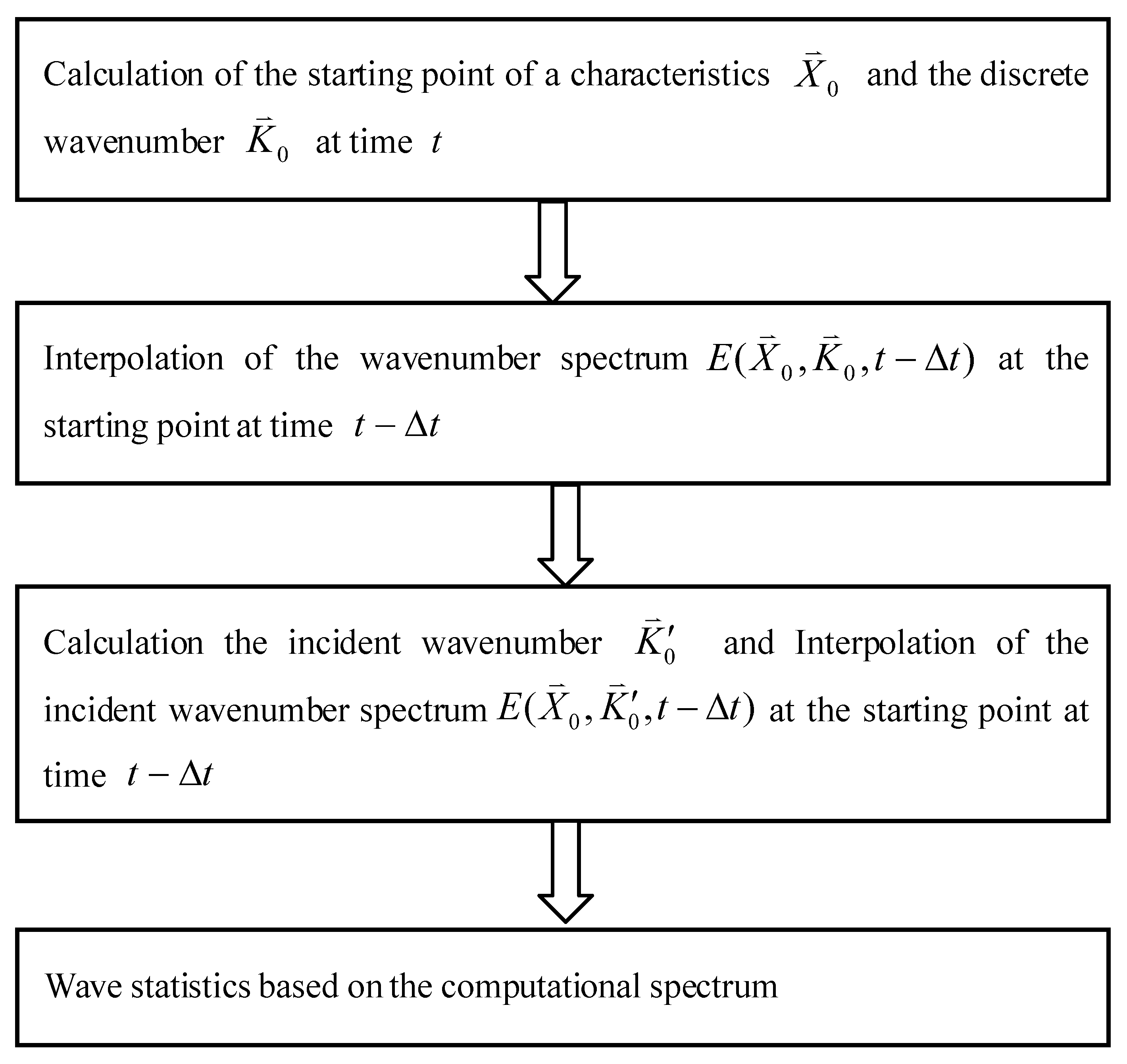


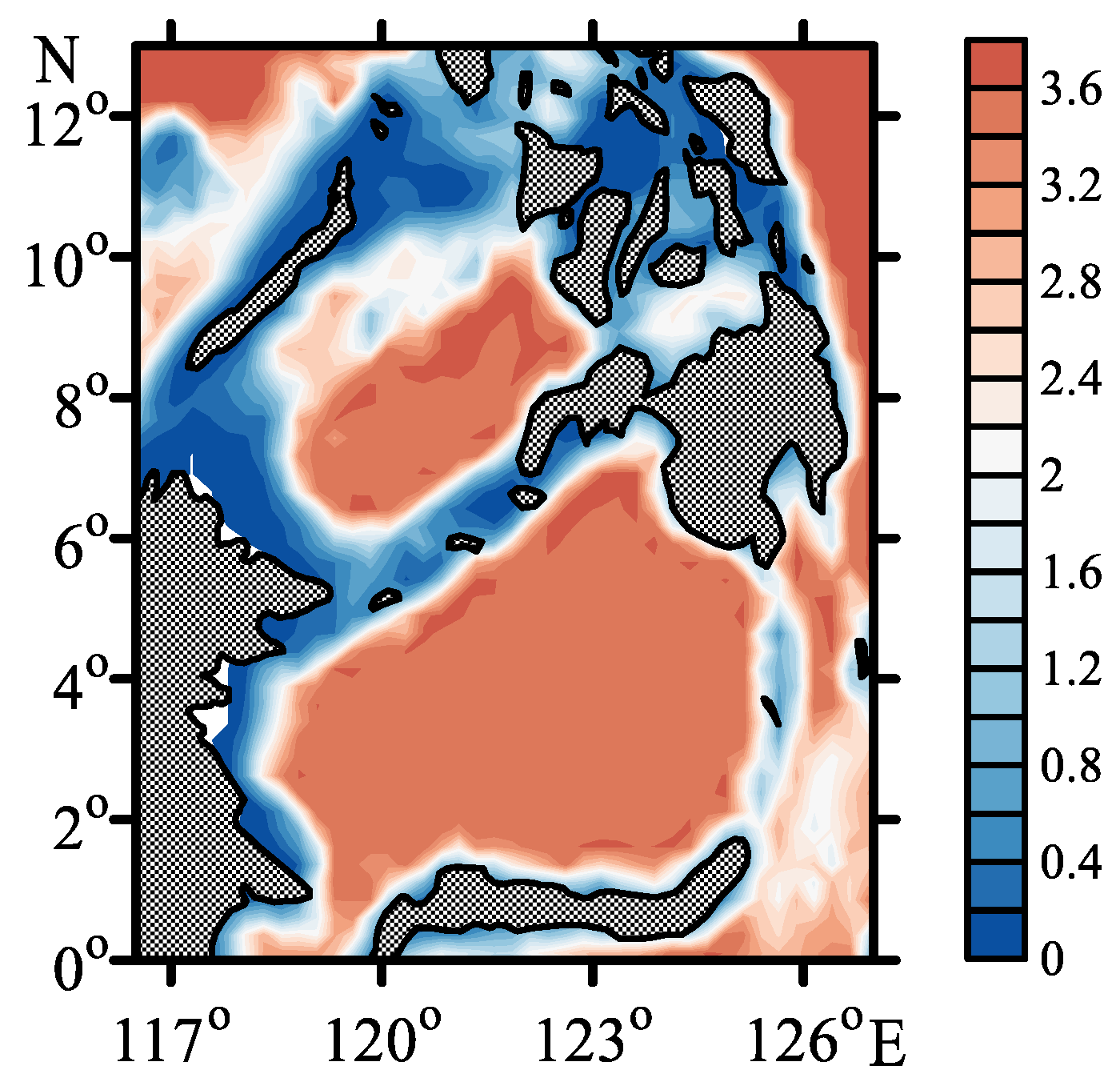


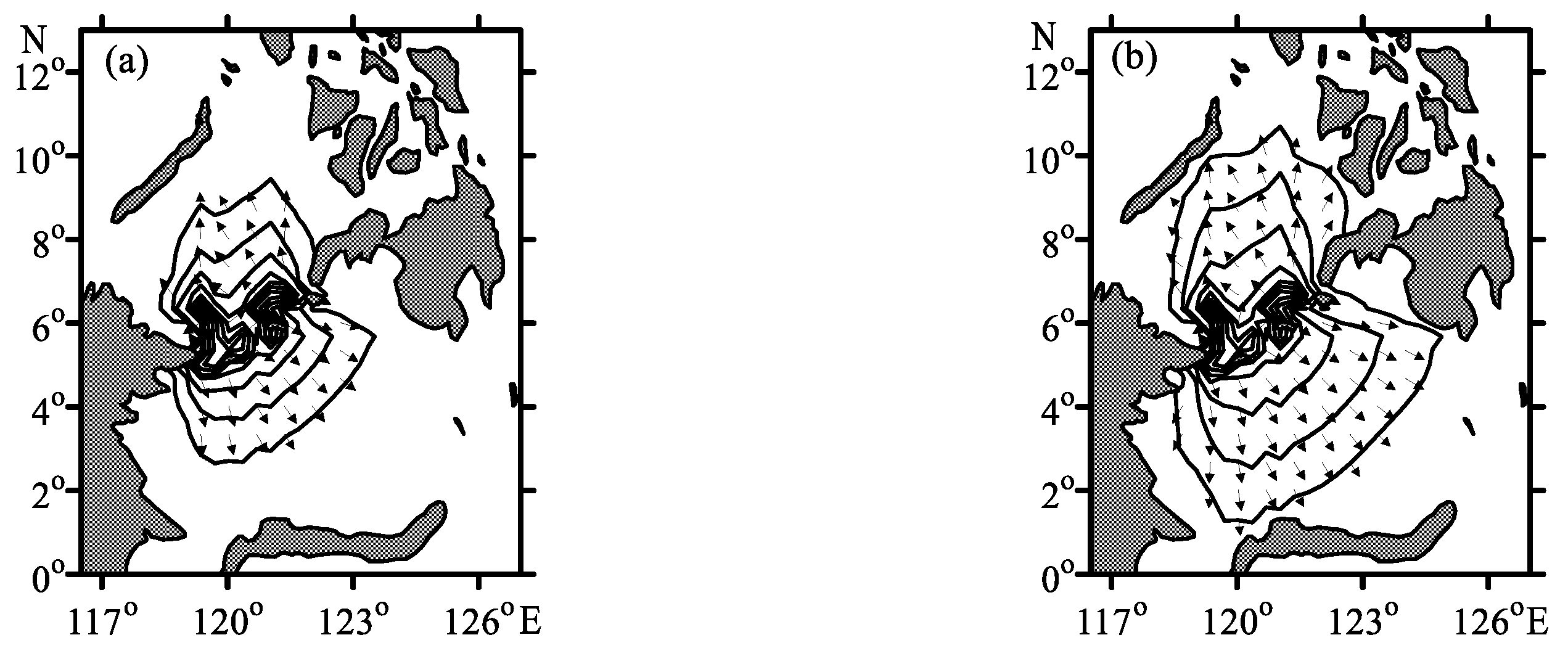
| Area | Internal Waves | First Crest Line Length (km) | Wavelength (km) | Apparent Phase Velocity (m/s) | ||
|---|---|---|---|---|---|---|
| MODIS | Model | MODIS | Model | |||
| Sulu Sea | Packet 1 | 126.79 | 102.14 | 52.03 | 2.28 | 1.17 |
| Packet 2 | 173.12 | 104.97 | 122.90 | 2.35 | 2.75 | |
| Packet 3 | 210.11 | 99.34 | 84.49 | 2.22 | 1.89 | |
| Packet 4 | 263.93 | 97.34 | 119.10 | 2.17 | 2.67 | |
| Packet 5 | 367.38 | - | - | |||
| Celebes Sea | ISW 1 | 57.94 | 121.40 | 139.80 | 2.71 | 3.13 |
| ISW 2 | 251.83 | 140.81 | 159.50 | 3.15 | 3.57 | |
| ISW 3 | 316.84 | 124.62 | 137.20 | 2.79 | 3.08 | |
| ISW 4 | 248.71 | - | - | |||
Publisher’s Note: MDPI stays neutral with regard to jurisdictional claims in published maps and institutional affiliations. |
© 2022 by the authors. Licensee MDPI, Basel, Switzerland. This article is an open access article distributed under the terms and conditions of the Creative Commons Attribution (CC BY) license (https://creativecommons.org/licenses/by/4.0/).
Share and Cite
Yang, Y.; Sun, M.; Sun, L.; Xia, C.; Teng, Y.; Cui, X. A Characteristics Set Computation Model for Internal Wavenumber Spectra and Its Validation with MODIS Retrieved Parameters in the Sulu Sea and Celebes Sea. Remote Sens. 2022, 14, 1967. https://doi.org/10.3390/rs14091967
Yang Y, Sun M, Sun L, Xia C, Teng Y, Cui X. A Characteristics Set Computation Model for Internal Wavenumber Spectra and Its Validation with MODIS Retrieved Parameters in the Sulu Sea and Celebes Sea. Remote Sensing. 2022; 14(9):1967. https://doi.org/10.3390/rs14091967
Chicago/Turabian StyleYang, Yongzeng, Meng Sun, Lina Sun, Changshui Xia, Yong Teng, and Xinmei Cui. 2022. "A Characteristics Set Computation Model for Internal Wavenumber Spectra and Its Validation with MODIS Retrieved Parameters in the Sulu Sea and Celebes Sea" Remote Sensing 14, no. 9: 1967. https://doi.org/10.3390/rs14091967
APA StyleYang, Y., Sun, M., Sun, L., Xia, C., Teng, Y., & Cui, X. (2022). A Characteristics Set Computation Model for Internal Wavenumber Spectra and Its Validation with MODIS Retrieved Parameters in the Sulu Sea and Celebes Sea. Remote Sensing, 14(9), 1967. https://doi.org/10.3390/rs14091967





